Some recent discussions in our town have highlighted the strategic importance of public and private partnerships. The potential result (after the hard work of collaboration) can be synergistic, meaning, the combined effect can be greater than the sum of the agencies involved. That’s creativity. And I’m reminded of something I witnessed this summer from another place and time that exhibited just this.
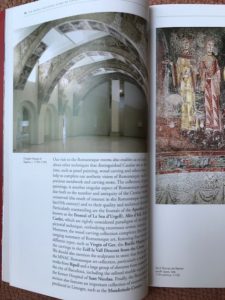 Barcelona’s National Museum of Catalonia has a collection of Romanesque murals that is unmatched by any museum in the world! Room after room gives one almost a time-machine opportunity to enter spaces that were situated in humble towns in the Pyrenees Mountains of Eastern Spain. These murals and sculptural pieces were then carefully removed to be preserved in the museum (imagine the public and private involvement to carry that feat out). Arranged in chronological (therefore stylistic) order, the spaces reveal the emerging imagery from small churches of the medieval period (11th-13thcenturies). What’s available then is a visualization of homegrown private conviction which was developed then displayed for public engagement. What was once internal became publically shared and what was then public becomes privately better understood. And this then down thru centuries for others to consider. Past into present. Imagine that ripple effect.
Barcelona’s National Museum of Catalonia has a collection of Romanesque murals that is unmatched by any museum in the world! Room after room gives one almost a time-machine opportunity to enter spaces that were situated in humble towns in the Pyrenees Mountains of Eastern Spain. These murals and sculptural pieces were then carefully removed to be preserved in the museum (imagine the public and private involvement to carry that feat out). Arranged in chronological (therefore stylistic) order, the spaces reveal the emerging imagery from small churches of the medieval period (11th-13thcenturies). What’s available then is a visualization of homegrown private conviction which was developed then displayed for public engagement. What was once internal became publically shared and what was then public becomes privately better understood. And this then down thru centuries for others to consider. Past into present. Imagine that ripple effect.
 Here is a wooden altar panel I especially loved for its graphic punch, simplicity, and pattern. It’s a typical example of Byzantine flatness. Yet the abstraction of forms were rendered with human differentiation and quirkiness. The viewer of the time would have been able to relate. And the viewer now is carried into another world’s way of seeing, even if just catching a glimpse. What was private conviction of the artist became embedded in his public context, what simmered inwardly became visible for others to be able to look and see.
Here is a wooden altar panel I especially loved for its graphic punch, simplicity, and pattern. It’s a typical example of Byzantine flatness. Yet the abstraction of forms were rendered with human differentiation and quirkiness. The viewer of the time would have been able to relate. And the viewer now is carried into another world’s way of seeing, even if just catching a glimpse. What was private conviction of the artist became embedded in his public context, what simmered inwardly became visible for others to be able to look and see.
Here is an excerpted contemporary example (from a long but wonderful poem) I just came across from our own time. A. Underwood wrote “A Weight on Each Shoulder” after listening/learning/being in a church space in NYC:
It’s been veiled in plain sight
Big as all of our stories
Deep as mankind’s full plight
And as high as its glories
It’s the “veiled in plain sight” out-calling that keeps me looking/listening/working.
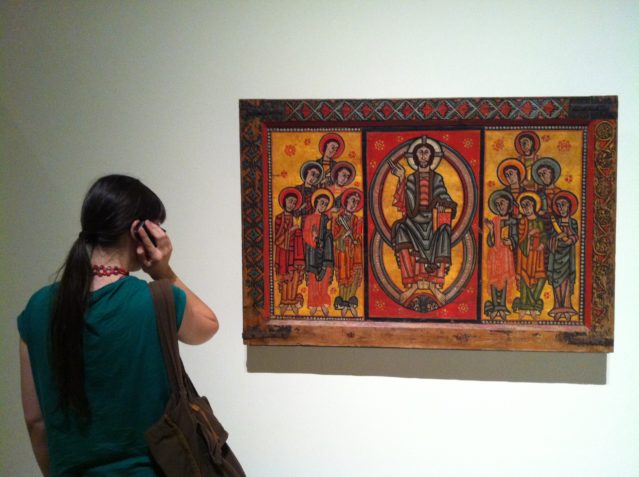
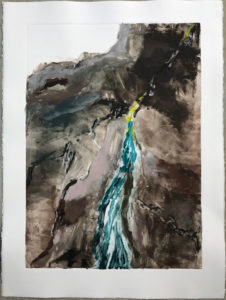
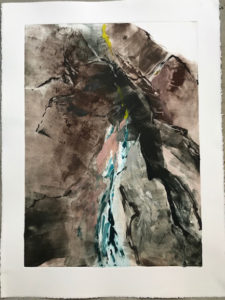 The journey of Moses leading the Hebrews out of slavery and into the land has informed some recent visual work. There’s a curious episode with water coming out of a rock that strangely happens twice:
The journey of Moses leading the Hebrews out of slavery and into the land has informed some recent visual work. There’s a curious episode with water coming out of a rock that strangely happens twice: 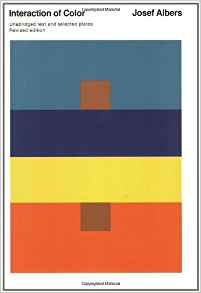 The mid 20th century Bauhaus instructor Joseph Albers was a master at helping his art students understand this. Using color chips and simple exercises, like “make five colors into six”, they learned the relativity of color. “In order to use color effectively, it is necessary to recognize that color deceives continually”, Albers said. Here is one exercise exampled. The brown squares are the same exact hue, but the reading of each is influenced by its surrounding colors. A dark context makes the center color lighter, a cool context makes the center color warmer and vice versa.
The mid 20th century Bauhaus instructor Joseph Albers was a master at helping his art students understand this. Using color chips and simple exercises, like “make five colors into six”, they learned the relativity of color. “In order to use color effectively, it is necessary to recognize that color deceives continually”, Albers said. Here is one exercise exampled. The brown squares are the same exact hue, but the reading of each is influenced by its surrounding colors. A dark context makes the center color lighter, a cool context makes the center color warmer and vice versa. All this and more fascinates me for the Creation account in Genesis 2 has God Himself getting his hands into the dirt, in time, on the ground to make things. Then we are tasked, after His exampling, to make things. It’s in the making that seeing is enhanced. It’s in the time taken and slowed down where relationships are better understood. It’s work, but strangely hope-filled.
All this and more fascinates me for the Creation account in Genesis 2 has God Himself getting his hands into the dirt, in time, on the ground to make things. Then we are tasked, after His exampling, to make things. It’s in the making that seeing is enhanced. It’s in the time taken and slowed down where relationships are better understood. It’s work, but strangely hope-filled. I didn’t stop on the highway to photograph the strange burger-joint billboard, just thought about it for the next, oh- maybe, 30 miles. There was the standard burger, and then the exhortation to “eat like you mean it.”
I didn’t stop on the highway to photograph the strange burger-joint billboard, just thought about it for the next, oh- maybe, 30 miles. There was the standard burger, and then the exhortation to “eat like you mean it.”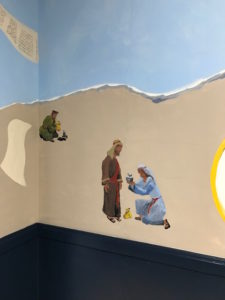 .
.



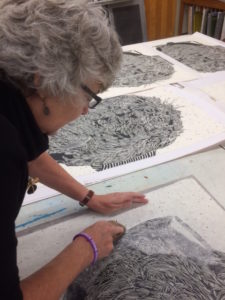 I’m not dressed for printmaking. Instead this one night, I attended an art opening of politically motivated art accompanied by an interesting lecture. The show’s juror,
I’m not dressed for printmaking. Instead this one night, I attended an art opening of politically motivated art accompanied by an interesting lecture. The show’s juror, 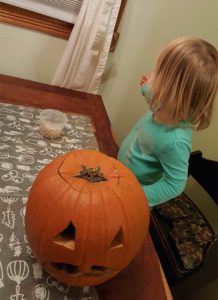 My granddaughter asked “what’s that?” as I was wiping up pumpkin mess. I looked up and saw her pointing to the wall and the round gray mimic cast by our big orange beauty. “That’s a shadow! Do you see how it moves as I slide this over? And if I turn the light off. . . it goes away! Isn’t that amazing? The light is what causes that shadow and the pumpkin is just blocking light on the wall. See, you can do the same thing with your hand: move your fingers and see how you can block the shine and change the shadow’s shape.” So, she got totally engaged with that exercise, and kept twinkling her fingers while I twinkled with thoughts.
My granddaughter asked “what’s that?” as I was wiping up pumpkin mess. I looked up and saw her pointing to the wall and the round gray mimic cast by our big orange beauty. “That’s a shadow! Do you see how it moves as I slide this over? And if I turn the light off. . . it goes away! Isn’t that amazing? The light is what causes that shadow and the pumpkin is just blocking light on the wall. See, you can do the same thing with your hand: move your fingers and see how you can block the shine and change the shadow’s shape.” So, she got totally engaged with that exercise, and kept twinkling her fingers while I twinkled with thoughts. I’m getting some expert help on the mural project we are spearheading for a local non-profit. But this face I reserved to do myself. This little girl is precious, with big ideas, so she is being placed on one of the most important parts of the wall. I love her funky glasses. I love most the reflection out from her eyes and even off the plastic lenses. That was really, really fun to paint!
I’m getting some expert help on the mural project we are spearheading for a local non-profit. But this face I reserved to do myself. This little girl is precious, with big ideas, so she is being placed on one of the most important parts of the wall. I love her funky glasses. I love most the reflection out from her eyes and even off the plastic lenses. That was really, really fun to paint!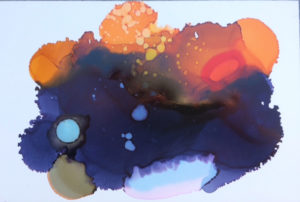 I struggle with my own voice in my work, living as I do in such a time of disintegration. I cannot make the work of my hands “say” what I hold in my heart so often. It is not my goal to be literal, but it is a desire to lift the viewer’s eyes. A friend of mine who is a photographer, grieving deeply over the death of her husband is now doing the best work of her career. We talked of this: why are we doing this work, this searching with images? Is it meaningful, is it what we “should be doing”? We got this far in our discussion: this work is an exploration into JOY. This expression is as fleeting as a sunset and as mysterious as a bird’s flight, but it is necessary, if even just for us. I have some ability to look, and to craft. Maybe through the work of my own hands others will see meaningfully also. For this, I keep on.
I struggle with my own voice in my work, living as I do in such a time of disintegration. I cannot make the work of my hands “say” what I hold in my heart so often. It is not my goal to be literal, but it is a desire to lift the viewer’s eyes. A friend of mine who is a photographer, grieving deeply over the death of her husband is now doing the best work of her career. We talked of this: why are we doing this work, this searching with images? Is it meaningful, is it what we “should be doing”? We got this far in our discussion: this work is an exploration into JOY. This expression is as fleeting as a sunset and as mysterious as a bird’s flight, but it is necessary, if even just for us. I have some ability to look, and to craft. Maybe through the work of my own hands others will see meaningfully also. For this, I keep on.